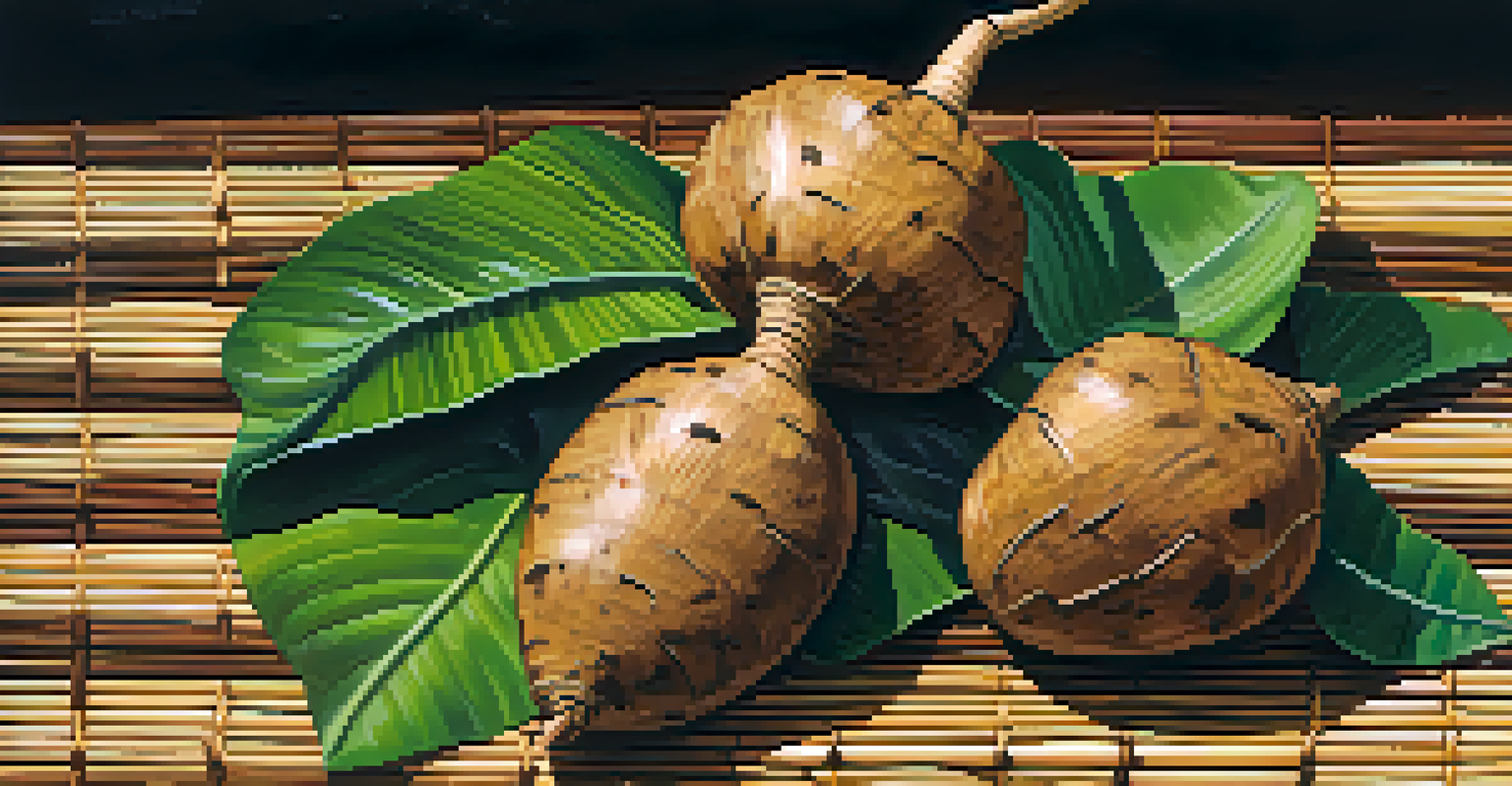Understanding the Role of Kalo in Hawaiian Culture and Health

Introduction to Kalo: The Heart of Hawaiian Agriculture
Kalo, or taro, is more than just a staple food in Hawaii; it's a cultural icon. This root vegetable has been cultivated in the islands for over a thousand years, serving as a primary food source for Native Hawaiians. Its significance goes beyond sustenance, deeply intertwining with traditions, spirituality, and the very identity of the Hawaiian people.
Kalo is not just a food. It is a symbol of life and a source of strength for our people.
In Hawaiian culture, Kalo is often viewed as a symbol of life and ancestry. Legends tell of the god Kane creating Kalo from his own stillborn son, making it a revered plant that honors lineage and heritage. This connection instills a sense of responsibility among Hawaiians to cultivate and preserve Kalo for future generations.
Today, Kalo farming practices reflect the values of sustainability and respect for the land. Traditional methods, including taro patches known as loʻi, showcase a harmonious relationship with nature, emphasizing the importance of environmental stewardship in Hawaiian culture.
Nutritional Benefits of Kalo: A Superfood for Health
Kalo is often celebrated as a 'superfood' due to its impressive nutritional profile. Rich in dietary fiber, vitamins, and minerals, it supports digestive health and provides sustained energy. Unlike many processed foods, Kalo is gluten-free and low in fat, making it an excellent option for a variety of diets.

The antioxidants found in Kalo help combat oxidative stress in the body, contributing to overall wellness. These compounds play a crucial role in reducing inflammation and may even lower the risk of chronic diseases. Incorporating Kalo into meals can be a delicious way to enhance your health naturally.
Kalo: Cultural Heritage and Identity
Kalo is a vital cultural icon in Hawaii, representing life, ancestry, and traditional values that are crucial to the identity of the Hawaiian people.
Moreover, Kalo is versatile in the kitchen. It can be prepared in numerous ways—mashed, steamed, or used to make poi, a traditional Hawaiian dish. This adaptability not only makes it a healthy choice but also a flavorful addition to any meal.
Cultural Significance of Kalo in Hawaiian Traditions
Kalo holds a special place in various Hawaiian traditions, rituals, and ceremonies. It is often featured in celebrations, symbolizing prosperity and connection to the ancestors. For many, preparing and sharing Kalo dishes is an act of love, reinforcing family bonds and cultural heritage.
In every taro leaf, we find the stories of our ancestors and the promise of our future.
In addition to its culinary uses, Kalo is often associated with spiritual practices. It is seen as a living entity, embodying the spirit of the land and ancestors. This reverence influences how Kalo is harvested and prepared, ensuring that it is treated with the utmost respect.
Hawaiian hula performances also frequently incorporate Kalo as a theme, celebrating its importance through dance and storytelling. This artistic expression not only honors Kalo but also educates audiences about its integral role in Hawaiian life.
Kalo in Modern Hawaiian Society: Challenges and Resilience
Despite its significance, Kalo farming faces challenges in modern Hawaiian society. Issues such as land development, invasive species, and climate change threaten traditional farming practices. Many local farmers are working tirelessly to combat these challenges and keep the Kalo legacy alive.
Community initiatives and organizations are emerging to educate the public about the importance of Kalo and sustainable farming practices. These efforts aim to inspire younger generations to connect with their cultural heritage and carry on the tradition of Kalo cultivation.
Nutritional Superfood Benefits
Rich in fiber, vitamins, and minerals, Kalo is celebrated as a superfood that supports health and wellness while being versatile in culinary applications.
Additionally, there is a growing movement to support local farmers through farmers' markets and farm-to-table restaurants. By choosing to buy Kalo and other local produce, residents can help sustain this vital part of Hawaiian culture and promote economic resilience.
The Role of Kalo in Hawaiian Healing Practices
Kalo is not only a dietary staple but also plays a role in Hawaiian healing practices. Traditionally, Kalo leaves are used to make poultices and wraps for various ailments, showcasing its medicinal properties. This underscores the holistic approach to health in Hawaiian culture, where food and healing are intricately connected.
Moreover, the act of planting and caring for Kalo is viewed as a therapeutic practice, promoting mental and emotional well-being. Engaging with nature in this way can reduce stress and foster a sense of community among practitioners.
In contemporary wellness practices, Kalo is often included in health-focused diets as a means to promote overall health. The integration of Kalo into modern wellness routines reflects a growing appreciation for traditional knowledge and its relevance today.
Kalo's Influence on Hawaiian Arts and Crafts
Beyond its culinary and health benefits, Kalo significantly influences Hawaiian arts and crafts. The plant's leaves, stems, and roots are utilized in various traditional crafts, from weaving to dyeing. This creative use of Kalo embodies the resourcefulness and creativity inherent in Hawaiian culture.
Artists often draw inspiration from Kalo, incorporating its imagery into paintings, sculptures, and textiles. These artistic expressions not only celebrate the beauty of Kalo but also serve as a reminder of its deep cultural roots.
Challenges and Community Resilience
Modern challenges such as climate change and land development threaten Kalo farming, prompting community initiatives to educate and inspire future generations to preserve this vital tradition.
Furthermore, educational programs that focus on Kalo-related art help to preserve traditional techniques and share the stories behind them. This fosters a sense of pride in Hawaiian identity while ensuring that the legacy of Kalo continues through generations.
Conclusion: Embracing the Legacy of Kalo in Hawaii
In conclusion, Kalo is a vital component of Hawaiian culture, health, and identity. Its significance extends beyond the plate, influencing traditions, healing practices, and the arts. As Hawaiians navigate the challenges of modern life, embracing Kalo's legacy becomes essential for cultural preservation and community resilience.
Supporting local Kalo farmers and participating in cultural practices not only honors this cherished plant but also strengthens the bonds within the community. By appreciating Kalo's role in Hawaiian life, we can ensure that its importance is recognized and celebrated for years to come.

Ultimately, Kalo serves as a symbol of connection—to the land, to our ancestors, and to each other. As we understand and embrace its multifaceted role in Hawaiian culture, we contribute to a vibrant narrative that honors the past while nurturing the future.